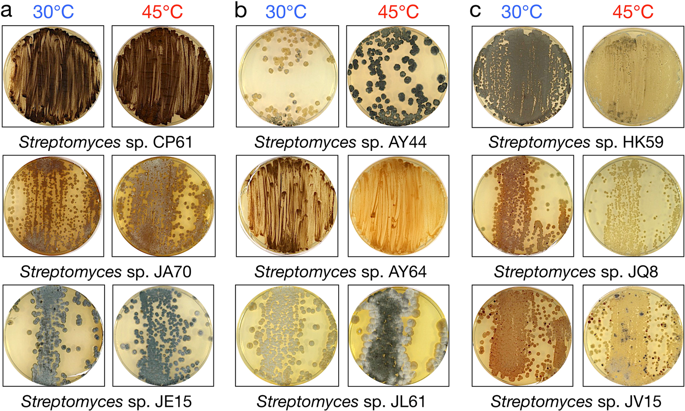当前位置:
X-MOL 学术
›
J. Antibiot.
›
论文详情
Our official English website, www.x-mol.net, welcomes your
feedback! (Note: you will need to create a separate account there.)
Discovery of "heat shock metabolites" produced by thermotolerant actinomycetes in high-temperature culture.
The Journal of Antibiotics ( IF 2.1 ) Pub Date : 2020-02-03 , DOI: 10.1038/s41429-020-0279-4 Shun Saito 1, 2 , Wataru Kato 1 , Hiroaki Ikeda 1 , Yohei Katsuyama 2, 3 , Yasuo Ohnishi 2, 3 , Masaya Imoto 1
The Journal of Antibiotics ( IF 2.1 ) Pub Date : 2020-02-03 , DOI: 10.1038/s41429-020-0279-4 Shun Saito 1, 2 , Wataru Kato 1 , Hiroaki Ikeda 1 , Yohei Katsuyama 2, 3 , Yasuo Ohnishi 2, 3 , Masaya Imoto 1
Affiliation

|
In actinomycetes, many secondary metabolite biosynthetic genes are not expressed under typical laboratory culture conditions and various efforts have been made to activate these dormant genes. In this study, we focused on high-temperature culture. First, we examined the thermotolerance of 3160 actinomycete strains from our laboratory culture collection and selected 57 thermotolerant actinomycetes that grew well at 45 °C. These 57 thermotolerant actinomycetes were cultured for 5 days in liquid medium at both 30 °C and 45 °C. Culture broths were extracted with 1-butanol, and each extract was subjected to LC/MS analysis. The metabolic profiles of each strain were compared between the 30 °C and 45 °C cultures. We found that almost half of these thermotolerant actinomycetes produced secondary metabolites that were detected only in the 45 °C culture. This result suggests that high-temperature culture induces the production of dormant secondary metabolites. These compounds were named "heat shock metabolites (HSMs)." To examine HSM production in more detail, 18 strains were selected at random from the initial 57 strains and cultivated in six different media at 30 °C and 45 °C; as before, metabolic profiles of each strain in each medium were compared between the 30 °C and 45 °C cultures. From this analysis, we found a total of 131 HSMs. We identified several angucycline-related compounds as HSMs from two thermotolerant Streptomyces species. Furthermore, we discovered a new compound, murecholamide, as an HSM from thermotolerant Streptomyces sp. AY2. We propose that high-temperature culture of actinomycetes is a convenient method for activating dormant secondary metabolite biosynthetic genes.
中文翻译:

在高温培养中发现耐热放线菌产生的“热休克代谢物”。
在放线菌中,许多次生代谢产物生物合成基因在典型的实验室培养条件下不表达,并且已经进行了各种努力来激活这些休眠基因。在这项研究中,我们专注于高温培养。首先,我们检查了实验室培养物中3160株放线菌的耐热性,并选择了57株在45°C下生长良好的耐热放线菌。将这57种耐热放线菌在30℃和45℃的液体培养基中培养5天。用1-丁醇萃取培养液,并对每种萃取物进行LC / MS分析。比较了每种菌株在30°C和45°C培养物中的代谢曲线。我们发现,这些耐热放线菌几乎有一半产生的次级代谢产物仅在45°C的培养物中才能检测到。该结果表明高温培养诱导休眠的次级代谢产物的产生。这些化合物被称为“热休克代谢物(HSM)”。为了更详细地检查HSM的产生,从最初的57个菌株中随机选择了18个菌株,并在30°C和45°C的6种不同培养基中进行培养。如前所述,在30°C和45°C的培养物中比较了每种菌株在每种培养基中的代谢谱。通过该分析,我们发现了总共131个HSM。我们从两个耐热链霉菌种中鉴定了几种与环霉素相关的化合物作为HSM。此外,我们从耐热链霉菌属菌种中发现了一种新化合物murecholamide作为HSM。AY2。
更新日期:2020-02-03
中文翻译:

在高温培养中发现耐热放线菌产生的“热休克代谢物”。
在放线菌中,许多次生代谢产物生物合成基因在典型的实验室培养条件下不表达,并且已经进行了各种努力来激活这些休眠基因。在这项研究中,我们专注于高温培养。首先,我们检查了实验室培养物中3160株放线菌的耐热性,并选择了57株在45°C下生长良好的耐热放线菌。将这57种耐热放线菌在30℃和45℃的液体培养基中培养5天。用1-丁醇萃取培养液,并对每种萃取物进行LC / MS分析。比较了每种菌株在30°C和45°C培养物中的代谢曲线。我们发现,这些耐热放线菌几乎有一半产生的次级代谢产物仅在45°C的培养物中才能检测到。该结果表明高温培养诱导休眠的次级代谢产物的产生。这些化合物被称为“热休克代谢物(HSM)”。为了更详细地检查HSM的产生,从最初的57个菌株中随机选择了18个菌株,并在30°C和45°C的6种不同培养基中进行培养。如前所述,在30°C和45°C的培养物中比较了每种菌株在每种培养基中的代谢谱。通过该分析,我们发现了总共131个HSM。我们从两个耐热链霉菌种中鉴定了几种与环霉素相关的化合物作为HSM。此外,我们从耐热链霉菌属菌种中发现了一种新化合物murecholamide作为HSM。AY2。











































 京公网安备 11010802027423号
京公网安备 11010802027423号